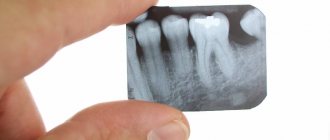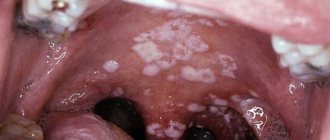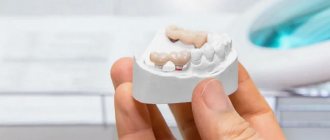Enamel composition
- Minerals (up to 95%);
- organic matter (1.2%);
- water (3.8%).
Depending on the thickness, the enamel changes color - from white to yellow. In the thinnest places where the dentin is visible, the tooth looks yellowed. The degree of mineralization affects the transparency of the tissue. The more minerals in the composition, the more transparent the surface will be. For this reason, baby teeth, which are less saturated with minerals than molars, look whiter.
- Enamel is a tissue that is not capable of regeneration, since it does not contain cells.
- It constantly metabolizes ions coming from saliva, dentin and pulp.
- The tissue is characterized by mutual permeability, with the least permeability characteristic of the external surfaces adjacent to the oral cavity.
Other structural features of enamel
The enamel also contains other components:
- Gunther-Schreger stripes - light and dark formations 100 microns wide, located perpendicular to the surface of the enamel (the result of longitudinal and transverse opening of enamel prisms);
- lines of Retzius in the form of symmetrical oblique arches, which in cross sections resemble growth rings on a tree trunk (these are the so-called growth lines, signaling the periodicity of mineralization processes);
- neonatal line - a dark stripe that separates the enamel formed before and after the birth of a child (visible in all baby teeth and in the first molar);
- enamel bundles and plates - enamel that contains hypomineralized prisms and the same interprismatic substance, with a high protein content.
Enamel plates are located from the surface inward, mainly in the area of the tooth neck, bundles are located in the inner layers, near the enamel-dentin junction. It is believed that microorganisms penetrate into the thickness of the enamel through these formations, contributing to the development of caries.
Medical Internet conferences
Introduction. Resistance to dental caries (DC) is ensured by the correct formation and formation of tooth buds and the physiological development of hard dental tissues [4, 12]. One of the conditions for tooth resistance to caries is the formation of a complete enamel structure, which begins with the formation of a protein matrix and ends with the mineralization of the enamel. The mineralization process is of great importance, the usefulness of which is ensured by a properly formed protein matrix [6, 8, 15]. Changes in the elemental composition of teeth make it possible to identify metabolic disorders during the development of teeth after eruption [13, 14], and therefore, the study of the chemical composition of the surface layers of enamel in these teeth is relevant.
The purpose of our study was to determine in vitro the degree of maturity of the enamel of permanent teeth and to study the content of microelements in its surface layers.
Object and methods of research. The study of dental surfaces using scanning electron microscopy was carried out at the Institute of Metal Physics named after G.V. Kurdyumov using equipment with the assistance of the Japanese company TOKYO BOEKI CIS LTD (manufactured by “Jeol”, Japan). To determine the microelement composition, the method of electron dispersive X-ray spectroscopy is indicative and accurate. The material for the study was the permanent third molars of children aged 16 to 18 years. Fifty-one unerupted intact permanent third molars, which were at the stage of root growth in length, were examined. The criteria for selecting permanent third molars were: similarity of developmental stages and morphology with permanent first molars in 6-year-old children, the possibility of obtaining material for research, namely extracted teeth for orthodontic reasons. The extracted teeth were washed with distilled water for three minutes. All samples were stored in tightly closed containers (10% streptomycin solution) at a temperature of (+2 ... + 4) ° C for two days.
Two days later, the studied samples were prepared for determination of trace element composition by electron dispersive X-ray spectroscopy. The content of chemical elements in the surface layer of permanent tooth enamel was determined in the equatorial, tubercular and cervical zones. The size of the areas of the enamel surface under study ranged from 50x50 µm to 250x250 µm (Fig. 1).
Rice.
Fig. 1. Area of study of immature enamel of a permanent tooth in an X-ray dispersive spectral analyzer INCA Energy 450. The content of chemical elements in the surface layer of enamel of a permanent tooth and the initial level of mineralization of each sample were determined using an X-ray characteristic spectrum (Fig. 2).
Rice. 2. X-ray characteristic spectrum of the surface layer of permanent tooth enamel.
When studying the surface of tooth enamel, the optimal magnification modes were determined (x100, x500, x1000, x3000) (Fig. 3-6).
Rice. 3. Immature enamel of a permanent tooth. Magnification x100.
Rice. 4. Immature enamel of a permanent tooth. Magnification x500.
Rice. 5. Immature enamel of a permanent tooth. Magnification x1000.
Rice. 6. Immature enamel of a permanent tooth. Magnification x3000.
Results and its discussion. When studying the chemical composition of tooth enamel using the EDS method, our studies determined similar indicators of the weight content of microelements (%): Ca2+ = 32.67 ± 8.07; Р5+=17.84±4.10; Na+ =0.84±1.23; Mg2+=0.15±0.11 (Table 1). In fact, we obtained results in which weight calcium and magnesium tended to decrease, and phosphorus and sodium were within normal limits [9].
By analyzing the atomic chemical composition of tooth enamel, we found that oxygen, sodium, chlorine, calcium, and phosphorus were determined in 100% of the samples. The elements Mg2+ were found in 63.89% of samples, F- in 30.56%, C4- in 13.89%, S2- in 8.33% of samples. The Ca2+ content was 18.87±6.28 (atom %), the P5+ content was 13.45±3.44 (atom %). The output level of mineralization by atomic (%) Ca/P ratio was 1.40 and was closer to the lower limit (1.33), after which irreversible changes in the enamel structure are observed [2]. A Ca/P ratio was found to be lower than the average values for human tooth enamel [1]. This shows that the enamel of teeth that have not erupted or have just erupted is immature.
At the same time, it has been established that the strength of dental tissue is influenced not only by the optimal ratio of basic microelements, such as calcium and phosphorus, but also by an increase in the amount of magnesium, sodium, potassium, silicon and a decrease in the content of sulfur and chlorine [3, 5].
Conclusion. The atomic chemical composition of the surface of tooth enamel made it possible to study electron dispersive spectral analysis. We found that 100% of the samples contained the following chemical elements: O2+, Na+, Cl-, Ca2+, P5+; Mg2+ was contained in 63.9% of the samples, F- in 30.6%, C4- in 13.9%, S2- in 8.3% of the samples. The Ca2+ content was 18.8±6.28 (atom%). The P5+ content is 13.45±3.44 (atom%). The output level of mineralization by atomic (%) ratio Ca/P was 1.40 and was closer to the lower limit (1.33). A lower Ca/P ratio was found than the average values for human tooth enamel. This shows that the enamel of teeth that just erupted was immature. The data we obtained coincide with the results of studying the content of fluorine, calcium and phosphorus in the enamel using X-ray photoelectron spectroscopy, which established an insufficient level of mineralization of the enamel of permanent teeth after eruption [10]. The presence of dental plaque on the teeth and the effect of other cariogenic factors, especially during this period, are very dangerous, which indicates the need to develop and carry out preventive measures, in particular exogenous ones, aimed at accelerating the mineralization of immature enamel of permanent teeth.
Determination of the chemical composition of immature enamel of permanent teeth using energy-dispersive X-ray spectroscopy is accurate and objective. Using this method, it is possible to reliably calculate the Ca/P coefficient of the enamel surface of permanent teeth, and thus determine the degree of maturity of the enamel of these teeth.
Features of the structure of the enamel of baby teeth
The thickness of the enamel of a temporary tooth is approximately half that of a permanent tooth, but this is not the only reason for the need for more frequent treatment of dental caries in children. It contains fewer minerals, and the Retzius lines are much less pronounced. Unlike the apically directed prisms of molars, in milk teeth they are located horizontally.
Due to the weakly defined layer of final enamel, prisms are clearly visible on the surface; pores and microcracks are present in large quantities due to numerous fascicles and plates. This is why children's teeth are more quickly damaged and suffer from caries more often.
How to strengthen tooth enamel?
The level of modern dentistry makes it possible to successfully eliminate tooth enamel defects through therapeutic and orthopedic techniques. In case of serious problems, it is necessary to use crowns, composite or ceramic veneers, but the best option is to preserve healthy and natural teeth. Today, many manufacturers offer various products that help avoid problems such as softening, erosion and thinning of tooth enamel.
Strengthening tooth enamel in adults
- Regular intake of vitamins B6 and B12, group D, as well as drugs that promote the absorption of calcium and fluoride.
- Therapeutic and prophylactic gels and toothpastes. Cleaning tooth enamel with non-abrasive products that contain calcium, fluoride and other components to strengthen the enamel.
- Mineralization of tooth enamel and regular preventive teeth cleaning. If you have naturally weak tooth enamel, these procedures are necessary to prevent the development of caries and other diseases. Tooth enamel whitening can be carried out only after consultation with your doctor, who will confirm the absence of contraindications.
- Prevention at home. Massage the gums, eat vegetables, fruits and legumes.
Remember that tooth enamel does not deteriorate in one day, but over many years, so the sooner you start caring for it, the longer you will maintain an attractive smile.
Strengthening tooth enamel in children
- Fluoridation. Application of special fluoride-containing varnishes to the surface of tooth enamel. After teething, the procedure is recommended to be carried out twice a year.
- The use of preventive mouth guards and application gels containing calcium, fluoride and vitamins.
- Fissure sealing to protect chewing teeth from caries.
Prevention and protection of tooth enamel in children will help to avoid serious problems in the future, so taking care of teeth should begin from the moment they erupt.










